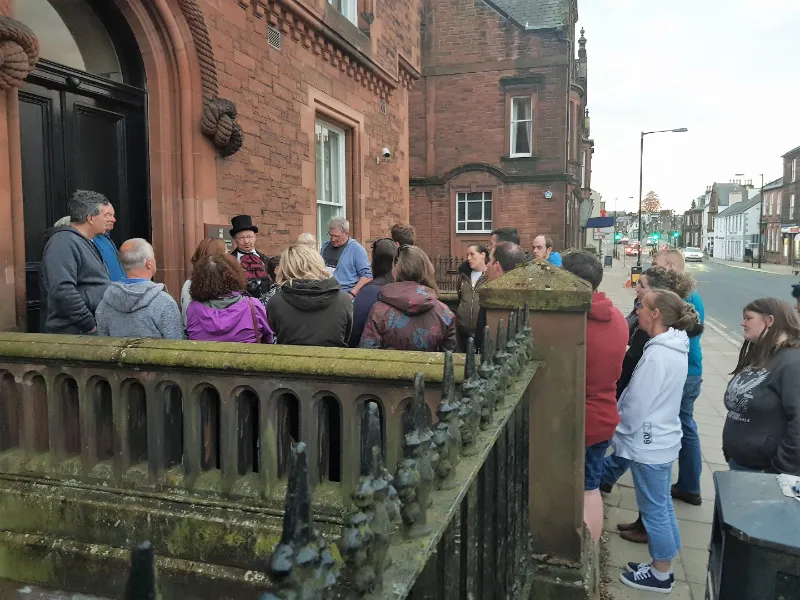Dumfries is a historically important town that can boast its fair share of grim and gruesome claims… This Friday, 12th May, marks the 155th anniversary of the last public execution in Scotland. Robert Colvin Smith was hanged for murder at the old Buccleuch Street Prison, ensuring his place in the annals of Scottish criminal history. Award-winning storytellers and tour creators – Mostly Ghostly – are gearing up for a return of their Deadly Dumfries tour – which focuses on this landmark case. Deadly Dumfries will document Smith’s story, in and around places he was linked with, and explore the macabre imprint it left on our town.
Team Founder Kathleen Cronie tells us about the tour:
“The darker side of human nature is endlessly compelling and this is certainly one of the darkest episodes we’ve researched in Dumfries and Galloway. We’ve been
intrigued by Robert Smith’s case for many years and most importantly, the story of Thomasina Scott – the nine-year-old girl who he so cruelly murdered. I have vivid memories of a primary school visit to Dumfries Museum in the 1980s when I saw Robert Smith’s death mask for the very first time. It was a chilling experience and I remember reading the display card and wondering who Thomasina was, and what
events had led to her death. There’s something very powerful about visiting places where real-life events have taken place, and our tour will connect guests with some of the key locations linked to the story. We hope they will gain a deeper insight into how the town of Dumfries featured in and influenced this historic case.”

On Tuesday, 12th May 1868, Robert Smith, a nineteen-year-old farm labourer from Eaglesfield, was led out to meet his fate, witnessed by a subdued crowd of about six hundred onlookers. In contrast to the raucous clamour which characterised some executions, the crowd conducted themselves with great dignity, and only a few dreadful shrieks erupted when Smith took his place on the scaffold.
Just a few months earlier on Saturday 1 st February, young Thomasina Scott, who lived in Cummertrees village, was running an errand for her mother, when a heavy downpour caused her to seek shelter in the home of Mrs Jane Crichton. It was there, at Longfords Farm, that she came into contact with Smith, who offered to accompany her on the road to Annan. The last person to see Thomasina was a witness named Thomson who identified her walking near the murder scene. Smith, having coaxed Thomasina into the dense arm of Crofthead Wood, robbed the child, before raping and strangling her. Thomasina’s body was discovered some hours later by a search party, which included members of her own family.
After the murder, Smith returned to the home of Mrs Crichton, in a brutal attempt to silence her, for fear she could implicate him in Thomasina’s death. Disturbed by visitors, Smith fled the scene and Mrs Crichton mercifully survived the violence of his attack.
Telling us more about the aftermath of the crimes, Team Member John Hill said: “Following his crimes, Smith made a number of fatal errors, and upon returning to Dumfries, made no real attempt to hide his tracks. He returned to a lodging house in the town – essentially, the first place the police would look – where he was apprehended by Superintendent John Malcolm. From there he was arrested, tried and found guilty. Smith fully admitted his crimes and given their severity, he was sentenced to death by public hanging. During his period of incarceration, Smith kept a fairly calm demeanour, finding comfort in religious studies and making his peace with God.”
At the time, a Bill was being passed in Parliament to put an end to the spectacle of public hangings, and some efforts were made for Robert Smith to be executed in private, however, it was found to be impossible.
On the day of the execution, hangman Thomas Askern arrived, dressed inappropriately in a white vest. Adding to the day’s tensions, he had to make some last-minute adjustments to the rope, before finally drawing the bolt. Askern’s reputation for botching executions was reinforced by the job that he did on Smith. Death was by no means swift and due to a misplaced noose, Smith’s convulsions, thankfully screened from view, lasted for a full nine minutes.
Between 1807 and 1868, Smith and seven others met their fates at the Old Buccleuch Street prison and some of these historic events will be discussed on the tour.
Kathleen tells us more:
“Guests will discover a collection of intriguing factual accounts, each presented with sensitivity and respect. Among them; they will learn of a jealousy-fuelled murder in an old close, the cold-blooded murder of a pedlar boy and the gut-wrenching account of a double execution.”
Summing up, Kathleen said:
“Deadly Dumfries explores a unique event in our region, and indeed the whole of Scotland. Through our passion for storytelling, we aim to inspire visitors, near and far, to learn about the town’s dark past, and in particular, the profound impact of crime and justice on the lives of real people.”






